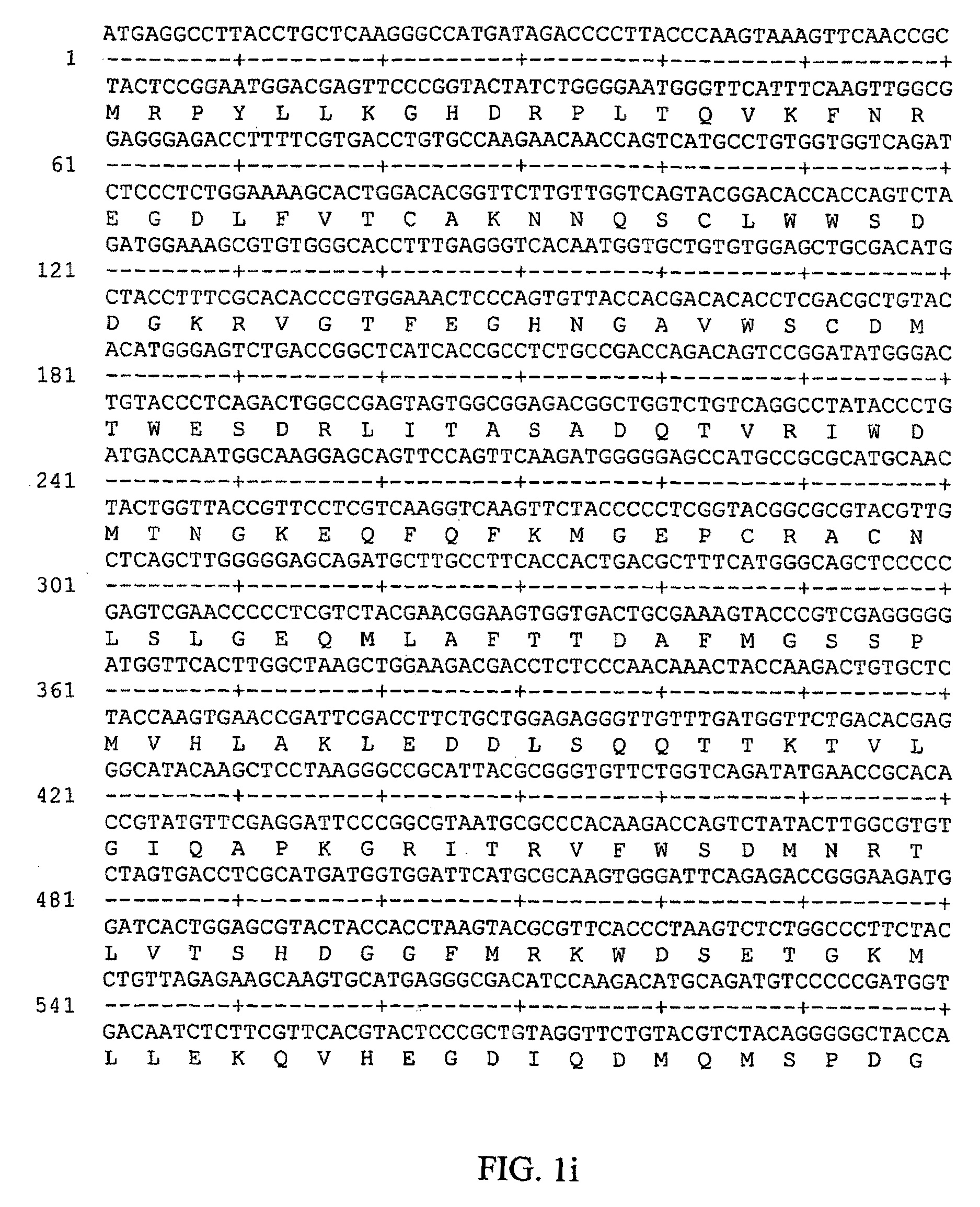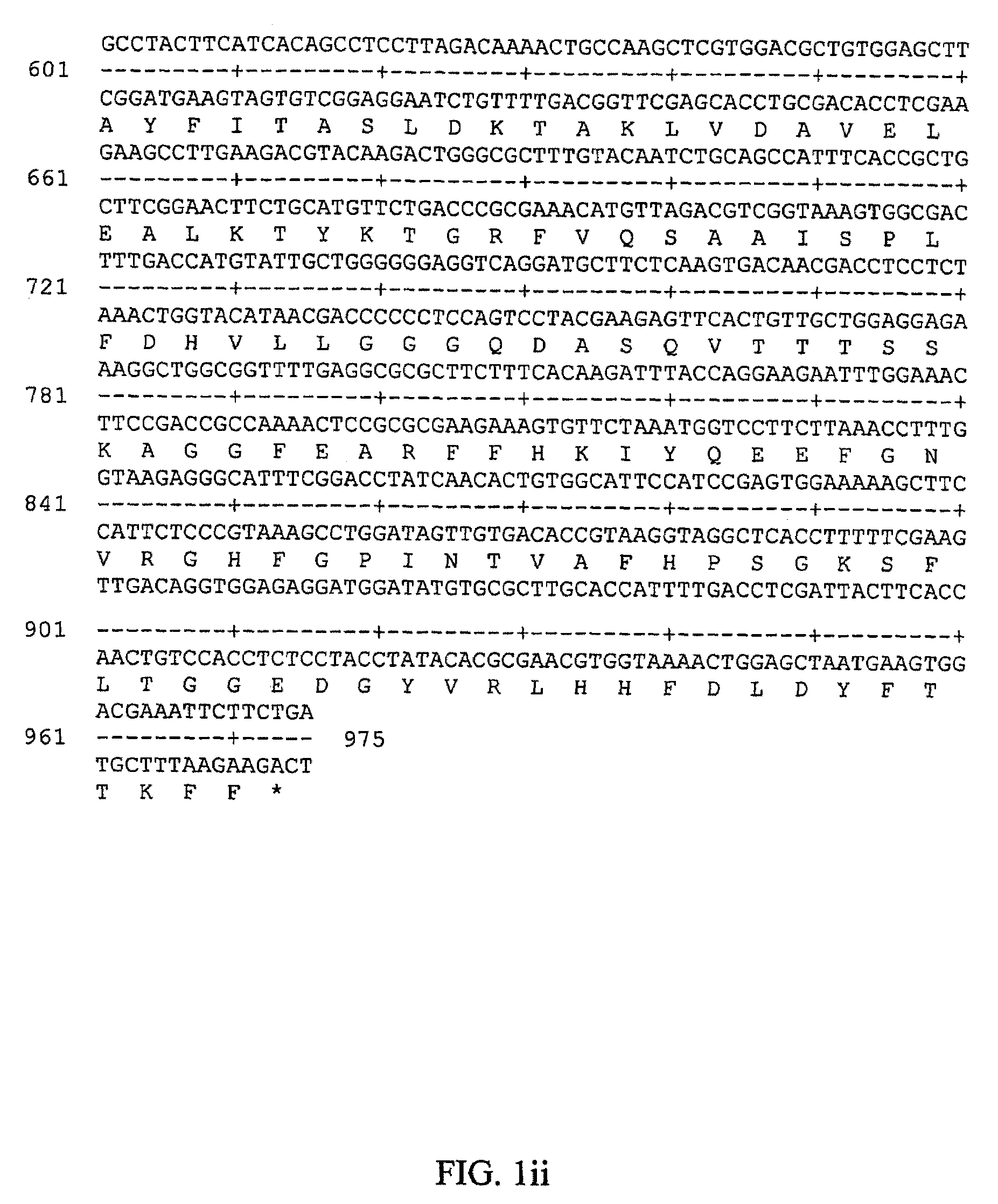Salt responsive genes useful for generating salt resistant transgenic plants
a technology of salt-responsive genes and transgenic plants, applied in the field of transgenic plants, can solve the problems of achieve the effect of conferring salt-resistant resistance and limited success of such approaches
- Summary
- Abstract
- Description
- Claims
- Application Information
AI Technical Summary
Benefits of technology
Problems solved by technology
Method used
Image
Examples
example 1
Salt-Inducible Genes / Proteins from Dunaliella salina as Tools to Enhance Plant Salt Tolerance
Genomic Screens for Salt-Inducible Genes in Dunaliella
[0140]Fluorescent Differential Display (FDD) of fluorescently labeled cDNA 3′-fragments was selected as the method of choice due to its high reliability and reproducibility. FDD was employed essentially as described in catalogs 1998 / 1999 and 2001 / 2002 of the manufacturer, GenHunter Corporation.
[0141]Over 1200 combinations of primers and total cDNAs from cells grown in a low- or high-salt containing media were screened by PCR amplification / Genscan analysis. Candidate salt-inducible mRNAs, as represented by 3′ fragments of corresponding cDNAs, were isolated from Fluoro-Imager scanned gels, checked for reproducibility and extent of salt-inducibility by quantitative RealTime PCR amplification. Confirmed clones served as a basis for cDNA sequence extension by several steps of 5′-RACE elongations-amplifications (see Example 2). Full-length cDN...
example 2
Preparation of cDNA by Rapid Amplification of cDNA Ends (RACE)
[0151]Previously conducted screens for salt-inducible genes yielded a group of partial-length cDNAs for potential salt-inducible genes from Dunaliella. Realtime RT-PCR analyses with these clones as templates and cDNAs for mRNAs from low or high-salt grown cells provided rigorous criteria for salt-inducibility. These segments were extended to the full length of the respective cDNAs by several extension steps using the 5′ RACE (rapid amplification of cDNA ends) procedure. The sequences of the full length cDNAs were used to screen the NCBI database for homologous sequences, as described in Example 1.
Outline of the Procedure
[0152]The Smart Race cDNA Amplification method provides a novel tool for performing both 5′- and 3′-rapid amplification of cDNA ends (RACE). This method allows isolating the complete 5′ sequence of the target transcript (cDNA) by eliminating the use of problematic adaptor ligation and enables the use of th...
example 3
Salinity Tolerance in Tobacco Plants Transformed with eIF3 Subunit
[0195]The eIF3 gene was cloned in a pGEM plasmid that was further cloned onto a plant transformation vector and introduced into Agrobacterium strain LBA4404. A mild strain of Agrobacterium tumefaciense (LBA 4404) harboring binary plasmid (pR-288 or pR-117 containing a selection marker cassette and a CaMV 35S promoter) was used for transformation. The cells were grown in 2YT medium containing 50 mg / l kanamycin and 50 mg / l rifampicin for 16-18 hours at 27±1° C. on rotary shaker (100 rpm). Acetosyringone was added to the final concentration of 100 μM 2 hours before transformation for pre-induction.
[0196]Tobacco plantlets were grown on MS medium supplemented with 3% sucrose and solidified with 6.5 g / l agar (Duchefa). The leaf segments were immersed in Agrobacterium culture and were wounded by cutting with a sharp blade. The leaf segments were co-incubated with Agrobacterium culture for 10 min. and subsequently blotted ont...
PUM
| Property | Measurement | Unit |
|---|---|---|
| Tm | aaaaa | aaaaa |
| Tm | aaaaa | aaaaa |
| temperature | aaaaa | aaaaa |
Abstract
Description
Claims
Application Information
 Login to View More
Login to View More - Generate Ideas
- Intellectual Property
- Life Sciences
- Materials
- Tech Scout
- Unparalleled Data Quality
- Higher Quality Content
- 60% Fewer Hallucinations
Browse by: Latest US Patents, China's latest patents, Technical Efficacy Thesaurus, Application Domain, Technology Topic, Popular Technical Reports.
© 2025 PatSnap. All rights reserved.Legal|Privacy policy|Modern Slavery Act Transparency Statement|Sitemap|About US| Contact US: help@patsnap.com



